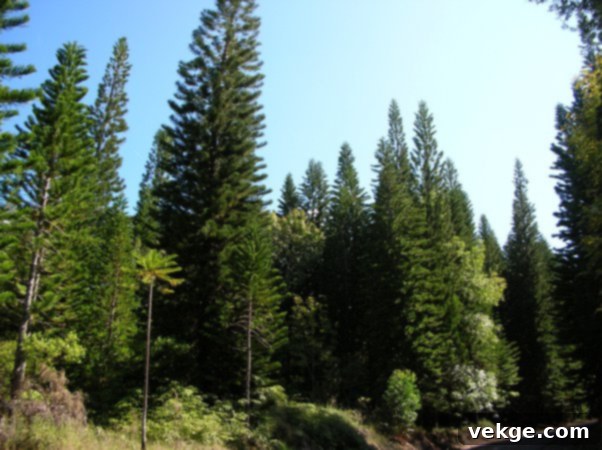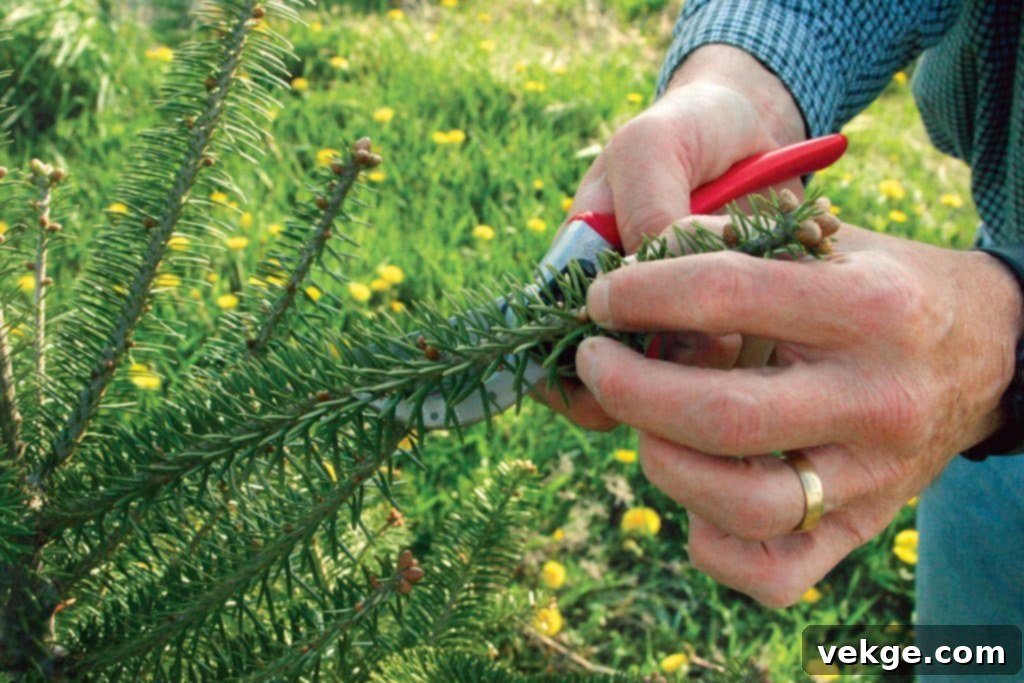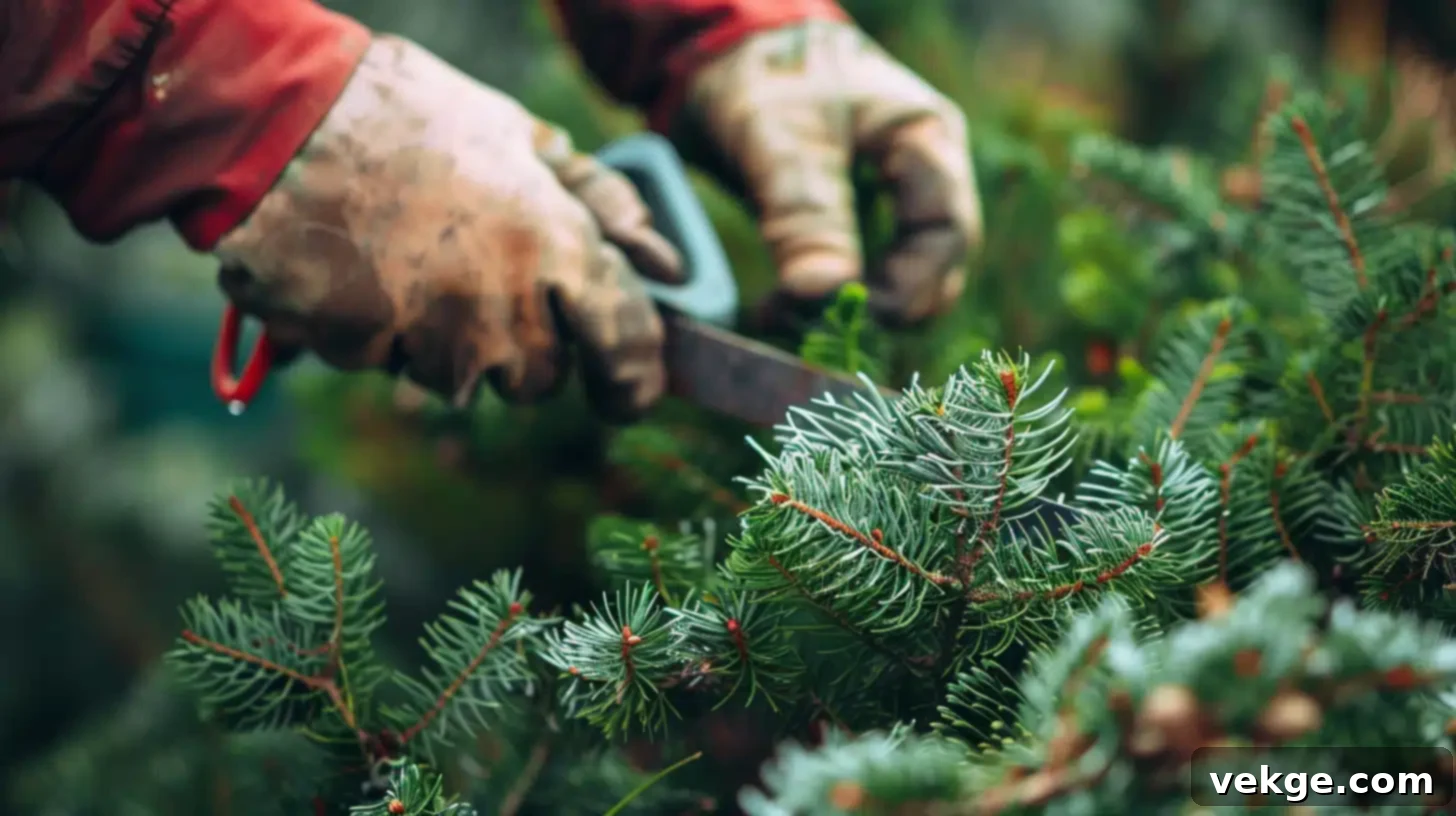Mastering Coniferous Tree Pruning: A Comprehensive Guide for Health, Beauty, and Longevity
Coniferous trees, often referred to as evergreens, are a magnificent and diverse group of trees celebrated for their distinctive needle-shaped leaves and cone-bearing nature. From the towering majesty of a mature pine to the delicate charm of a dwarf spruce, these trees grace our landscapes with year-round greenery, providing essential habitat and food sources for a variety of wildlife. Their enduring presence and unique aesthetic make them a staple in many gardens and natural environments.
While often perceived as low-maintenance compared to their deciduous counterparts, coniferous trees greatly benefit from proper care, with pruning being a critical component of their long-term health and vigor. Pruning involves the selective removal of branches, a practice that not only enhances the tree’s health and structural integrity but also significantly improves its overall appearance. Understanding the ‘why,’ ‘when,’ and ‘how’ of pruning evergreens is essential for any homeowner or landscaper looking to cultivate robust, beautiful, and resilient coniferous trees.
1. Characteristics of Coniferous Trees: Understanding Your Evergreens

Description of Coniferous Trees: Diversity in Form and Function
Coniferous trees are incredibly versatile, showcasing a remarkable range in form, size, and shape. This group includes a vast array of species such as pines, spruces, firs, cedars, junipers, and yews, each with its unique characteristics. While many conifers exhibit the classic cone-shaped or columnar silhouette, designed to shed snow effectively, others display spreading, weeping, or even irregular forms. Their branches typically radiate from a central trunk, forming a canopy that provides dense shade and shelter. Their signature needle-like or scale-like leaves, which remain green through all seasons, are specially adapted to retain moisture, allowing them to thrive in various climates and soil conditions.
Growth Habits and Forms: Shaping the Landscape
The diverse growth habits of coniferous trees offer a wealth of choices for landscape design. You’ll find upright and stately forms perfect for creating strong vertical accents, spreading varieties ideal for ground cover or screening, and elegant weeping forms that add a touch of drama. Dwarf conifers are increasingly popular for rock gardens, containers, and small spaces, providing intricate texture and year-round interest without overpowering the area. Many conifers develop dense foliage, making them excellent choices for privacy screens and windbreaks, while others have more open branching structures that showcase their graceful forms and allow light to filter through. Understanding these inherent growth patterns is the first step toward effective pruning, as it informs how you can best enhance a tree’s natural beauty or direct its growth to serve a specific purpose in your landscape.
2. Reasons for Pruning Coniferous Trees: More Than Just Aesthetics

Enhancing Tree Health and Vigor: A Proactive Approach
Regular and judicious pruning is a cornerstone of maintaining the long-term health and vigor of coniferous trees. By selectively removing dead, diseased, or damaged branches, you significantly reduce the risk of pests and diseases taking hold or spreading throughout the tree. Diseased branches, if left unaddressed, can become entry points for pathogens, compromising the entire tree’s immune system. Pruning also improves air circulation within the canopy, which is crucial for preventing fungal issues, especially in dense evergreens. Furthermore, by removing unproductive or compromised branches, the tree can reallocate its vital resources – water, nutrients, and energy – to healthy growth, leading to a stronger, more resilient specimen with a robust root system and vibrant foliage.
Improving Aesthetic Appeal: Sculpting Natural Beauty
Beyond health, pruning plays a pivotal role in shaping coniferous trees into attractive specimens that complement their surroundings and enhance the overall landscape design. Strategic trimming can encourage a more balanced and symmetrical canopy, correcting irregular growth patterns and preventing overcrowding. For formal gardens, careful pruning can create defined shapes and lines, while in naturalistic settings, it can subtly refine the tree’s inherent form. Pruning can also be used to ‘lift’ the canopy by removing lower branches, allowing for better visibility, pedestrian access, or to showcase underplanting. This aesthetic management ensures your evergreens remain an asset to your property, integrating seamlessly with your outdoor space. Check out our other 10 tips for transforming your outdoor space with residential landscaping.
Addressing Structural Issues: Ensuring Safety and Stability
Pruning is an indispensable tool for mitigating and correcting structural problems that could otherwise compromise a tree’s stability and safety. Common issues include weak or narrow crotch angles, co-dominant stems that compete for resources and create weak points, and rubbing branches that can cause wounds and lead to decay. By identifying and addressing these problems early, you can improve the tree’s overall architecture, strengthen its framework, and reduce the risk of branches breaking off during high winds or heavy snowfalls. This proactive approach not only extends the tree’s lifespan but also safeguards property and people from potential hazards caused by falling limbs.
3. When to Prune Coniferous Trees: Timing is Everything
Seasonal Timing for Pruning: The Dormant Advantage
The optimal time for significant pruning of most coniferous trees is during their dormant period, typically in late winter or early spring, before new growth begins. Pruning at this time minimizes stress on the tree because sap flow is reduced, and the tree has an entire growing season to recover and heal wounds. The absence of foliage also provides a clearer view of the tree’s structure, making it easier to identify branches that need removal. However, light maintenance pruning to remove unhealthy, dead, or clearly damaged branches can generally be performed at any time of year without significant harm to the tree. Always aim to avoid pruning during periods of extreme heat or drought, as this can add unnecessary stress.
Considerations for Specific Conifer Species: Tailored Approaches
Different conifer species respond uniquely to pruning, making it crucial to consider their individual growth habits and needs. For instance, pines and spruces, which typically grow from terminal buds, often require a more aggressive approach known as “candle pruning” – snipping the new, soft growth (candles) in spring to control size and density. Firs and cedars, on the other hand, usually only require minimal pruning for shaping and removing deadwood, as they don’t regenerate new growth from old wood as readily. Junipers and yews are more tolerant of shearing and can be shaped more formally. Always research the specific requirements of your conifer species to ensure you apply the most appropriate and beneficial pruning techniques, avoiding methods that could cause irreversible damage.
Pruning After Storms: Immediate Damage Control
Following a storm, an immediate inspection of your property’s trees is crucial. High winds, heavy rain, snow, or ice can cause significant damage, resulting in broken, cracked, or hanging branches. Any damaged or hazardous branches should be pruned or removed promptly to prevent further injury to the tree or safety risks to people and property. Prioritize branches that are hanging precariously, obstructing pathways, or posing an immediate danger. While safety is paramount, it’s also important to make clean cuts to help the tree recover effectively. For extensive storm damage, especially with large branches or trees near structures, it is highly recommended to consult with a certified arborist. See what are some other dos and don’ts for tree care after a storm.
4. How to Prune Coniferous Trees: Techniques and Tools for Success
Tools and Equipment: Essential Gear for Clean Cuts
Having the right tools is fundamental for effective and safe pruning. For small twigs and branches up to a half-inch thick, sharp hand pruners (bypass type is generally preferred) are ideal. Loppers, with their longer handles, provide leverage for branches up to 1.5 to 2 inches in diameter. For larger branches, a pruning saw is necessary. Pole pruners are invaluable for reaching higher branches without the need for a ladder, enhancing safety. Always ensure your tools are sharp and clean to make precise cuts that heal quickly and prevent the spread of diseases. Disinfecting tools between trees, especially if one shows signs of disease, is a good practice.
Techniques for Proper Pruning: Preserving Tree Health
When pruning coniferous trees, employing the correct techniques is paramount to protect the tree from harm and encourage robust regeneration. The most critical principle is to make precise cuts that do not damage the branch collar – the slightly swollen area where a branch joins the trunk or a larger branch. This collar contains specialized cells that facilitate wound healing. For larger branches, use the “three-cut method” to prevent bark tearing: first, an undercut about a foot from the trunk; second, a top cut further out on the branch to remove most of the weight; and third, a final clean cut just outside the branch collar. Avoid flush cuts (cutting too close to the trunk) or leaving stubs, as both can hinder proper wound closure and invite pests and diseases. Focus on thinning cuts, which remove an entire branch back to its point of origin, rather than heading cuts, which shorten a branch and can lead to unnatural, bushy growth.
5. Tips for Pruning Coniferous Trees Safely: Prioritizing Protection
Safety Precautions: Protecting Yourself and Your Trees
Safety should always be the top priority when undertaking any tree pruning activity. Always wear appropriate personal protective equipment (PPE), including protective goggles or safety glasses to shield against flying debris, sturdy gloves to protect your hands, and supportive, non-slip footwear. For overhead work, a hard hat is advisable. Use caution with sharp tools and ensure you have a stable footing, especially when using ladders. Never prune near power lines; always contact your local utility company for assistance. Avoid pruning in adverse weather conditions, such as strong winds, heavy rain, or icy conditions, as these significantly increase the risk of accidents. For large trees or complex pruning tasks, particularly those involving heavy branches or working at significant heights, it is always best to engage a certified arborist who possesses the necessary equipment, expertise, and insurance.
Proper Pruning Practices: A Step-by-Step Approach
Before making any cuts, take time to assess the tree’s overall health, structure, and your desired outcome. Begin by identifying and marking the branches that need to be removed. Your primary focus should be on dead, diseased, or damaged branches, followed by crossing or rubbing branches, and then any that detract from the tree’s natural form or create structural weaknesses. Work methodically from the bottom up, pruning one branch at a time. Regularly step back to evaluate your progress and ensure the canopy remains balanced and symmetrical. Remember the “less is more” principle: it’s easier to remove more later than to correct an over-pruned tree. Aim to remove no more than 25-30% of the live crown in a single pruning season to avoid unduly stressing the tree.
6. Common Mistakes to Avoid When Pruning Coniferous Trees: Learning from Errors
Over-pruning: The Detrimental Effects of Excess
One of the most frequent mistakes made by both amateur and experienced gardeners is over-pruning, which involves removing too many branches at once or taking too much off individual branches. Over-pruning can severely stress the tree, disrupt its natural growth patterns, and significantly reduce its ability to photosynthesize, leading to sparse foliage and weak, susceptible branches. In severe cases, it can even lead to the tree’s decline or death. Conifers, especially, can be unforgiving if over-pruned, as many species do not readily produce new growth from old wood. Always adhere to the guideline of removing no more than 25-30% of the live canopy in a single year, focusing on selective removal rather than aggressive reduction.
Incorrect Pruning Techniques: Long-Term Damage
Another common and often devastating mistake is employing incorrect pruning techniques. Two particularly harmful practices are “topping” and “lion-tailing.” Topping involves cutting off the tops of main branches or the central leader, which destroys the tree’s natural form and forces the growth of numerous weak, upright shoots (often called “water sprouts” or “witches’ brooms”). These sprouts are poorly attached and prone to breaking. Lion-tailing, on the other hand, involves stripping off all the lowest branches from a main branch, leaving only a tuft of foliage at the end, akin to a lion’s tail. This practice weakens the branch structurally, making it more susceptible to breakage, and exposes the inner canopy and bark to sun scald, increasing vulnerability to pests and diseases. Such actions can severely weaken the tree, making it more vulnerable to pests and diseases, and diminishing its aesthetic value. To protect your trees from such issues, you can turn to a tree surgery service for assistance, ensuring professional and correct techniques are applied.
Conclusion: Pruning Coniferous Trees for Optimal Health and Enduring Beauty
In summary, the art and science of pruning coniferous trees are incredibly beneficial when executed correctly. It is a fundamental practice that underpins the overall health, structural integrity, and aesthetic appeal of your evergreens. The ideal time for substantial pruning generally falls within the dormant season, typically from late winter to early spring, before the burst of new growth. During this period, the tree is less stressed, and healing can commence efficiently as temperatures rise. Light, annual maintenance pruning, focused on removing dead, diseased, or damaged branches, can be performed as needed throughout the year, always prioritizing clean cuts just outside the branch collar.
Mastering coniferous tree pruning involves more than just wielding a pair of shears; it requires an understanding of tree biology, species-specific needs, and a commitment to proper techniques and safety. By recognizing the critical reasons for pruning – enhancing health, improving aesthetics, and addressing structural issues – and adhering to best practices regarding timing, tool selection, and cutting methods, homeowners and landscapers can ensure their coniferous trees remain vibrant, resilient, and beautiful for generations to come. Thoughtful and consistent care transforms evergreens into lasting assets, contributing significantly to the beauty and ecological richness of any landscape.
